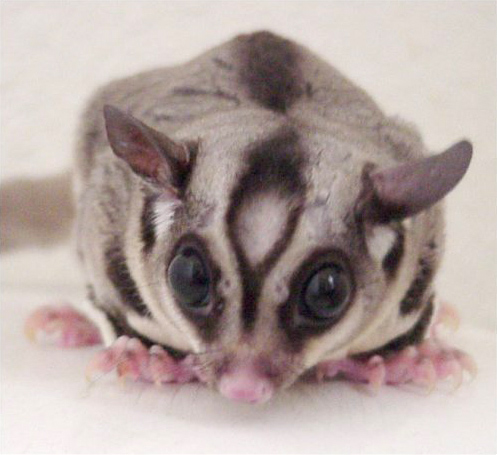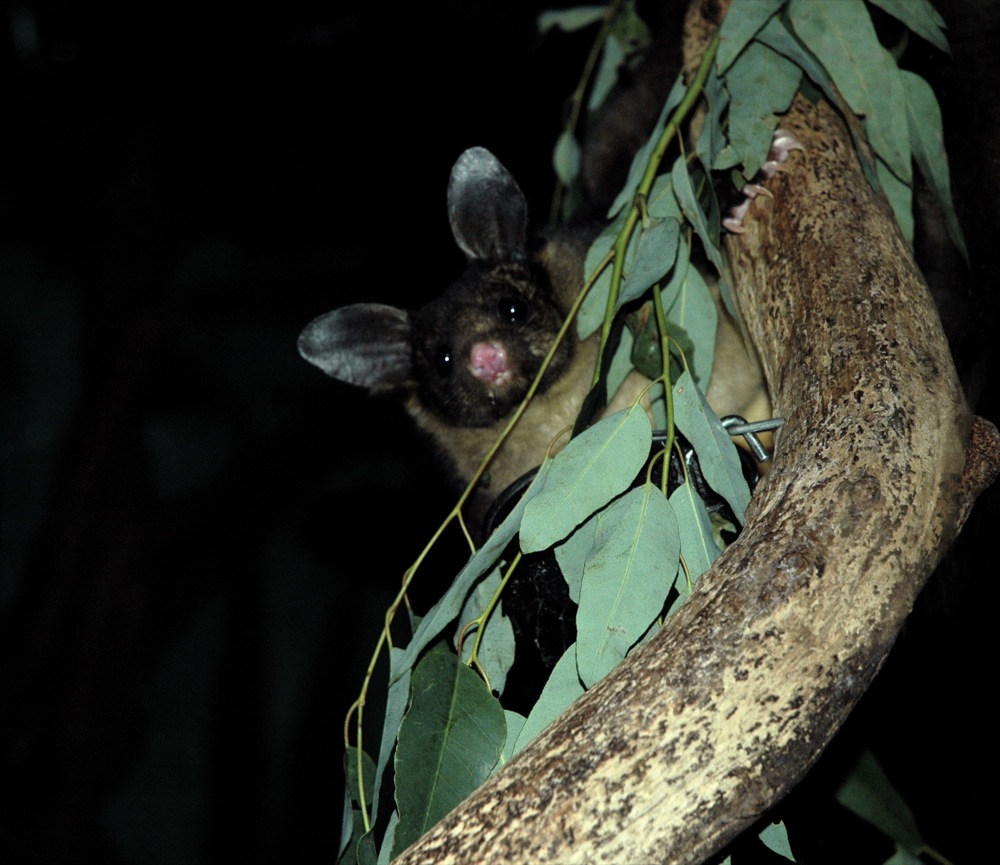|
Petaurus
The genus ''Petaurus'' () contains flying phalangers or wrist-winged gliders, a group of arboreal possums native to Australia, New Guinea, and surrounding islands. There are eight species: the sugar glider, savanna glider, Krefft's glider, squirrel glider, mahogany glider, northern glider, yellow-bellied glider and Biak glider. Flying phalangers are typically nocturnal, most being small (sometimes around 400 mm, counting the tail), and have folds of loose skin (patagia) running from the wrists to the ankles. They use the patagia to glide from tree to tree by jumping and holding out their limbs spread-eagle. They are able to glide for distances over 140 metres. Beside the distinctive skin folds, flying phalangers also have large, forward-facing eyes, short (though pointed) faces, and long flat tails which are used as rudders while gliding. All are omnivores, and eat tree sap, gum, nectar, pollen, and insects, along with manna and honeydew. Most flying phalangers appear ... [...More Info...] [...Related Items...] OR: [Wikipedia] [Google] [Baidu] |
Sugar Glider
The sugar glider (''Petaurus breviceps'') is a small, omnivorous, arboreal, and nocturnal gliding possum belonging to the marsupial infraclass. The common name refers to its predilection for sugary foods such as sap and nectar and its ability to glide through the air, much like a flying squirrel. They have very similar habits and appearance to the flying squirrel, despite not being closely related—an example of convergent evolution. The scientific name, ''Petaurus breviceps'', translates from Latin as "short-headed rope-dancer", a reference to their canopy acrobatics. The sugar glider is characterised by its pair of gliding membranes, known as patagia, which extend from its forelegs to its hindlegs. Gliding serves as an efficient means of reaching food and evading predators. The animal is covered in soft, pale grey to light brown fur which is countershaded, being lighter in colour on its underside. The sugar glider is native to a small portion of southeastern Australia, ... [...More Info...] [...Related Items...] OR: [Wikipedia] [Google] [Baidu] |
Sugar Glider
The sugar glider (''Petaurus breviceps'') is a small, omnivorous, arboreal, and nocturnal gliding possum belonging to the marsupial infraclass. The common name refers to its predilection for sugary foods such as sap and nectar and its ability to glide through the air, much like a flying squirrel. They have very similar habits and appearance to the flying squirrel, despite not being closely related—an example of convergent evolution. The scientific name, ''Petaurus breviceps'', translates from Latin as "short-headed rope-dancer", a reference to their canopy acrobatics. The sugar glider is characterised by its pair of gliding membranes, known as patagia, which extend from its forelegs to its hindlegs. Gliding serves as an efficient means of reaching food and evading predators. The animal is covered in soft, pale grey to light brown fur which is countershaded, being lighter in colour on its underside. The sugar glider is native to a small portion of southeastern Australia, ... [...More Info...] [...Related Items...] OR: [Wikipedia] [Google] [Baidu] |
Krefft's Glider
Krefft's glider (''Petaurus notatus'') is a species of arboreal nocturnal gliding possum, a type of small marsupial. It is native to most of eastern mainland Australia and has been introduced to Tasmania. Populations of ''Petaurus'' from New Guinea and Indonesia previously classified under ''P. breviceps'' are also tentatively classified under ''P. notatus'' by the American Society of Mammalogists, but likely represent a complex of distinct species. As most captive gliders referred to as " sugar gliders" in at least the United States are thought to originate from West Papua, this likely makes them Krefft's gliders, at least tentatively. Taxonomy It is closely allied with the sugar glider (''P. breviceps''), with which it was long taxonomically confused. A 2020 study partially clarified the taxonomy of the sugar glider and split it into three species: the savanna glider (''P. ariel''), the sugar glider (''P. breviceps sensu stricto'') and Krefft's glider (''P. notatus''). The la ... [...More Info...] [...Related Items...] OR: [Wikipedia] [Google] [Baidu] |
Yellow-bellied Glider
The yellow-bellied glider (''Petaurus australis''), also known as the fluffy glider, is an arboreal and nocturnal gliding possum that lives in native eucalypt forests in eastern Australia, from northern Queensland south to Victoria. Habitat The yellow-bellied glider inhabits forests and woodlands in eastern Australia and is found at a range of altitudes from sea level to 1400 metres. In North Queensland, the sub-species occurs at altitudes over 700 m above sea level. With natural discontinuities and habitat clearings, there are 13 different populations in three distinct places to find this glider in North Queensland. One population resides on Mount Windsor Tableland, another on Mount Carbine Tableland, and the third lives in a linear habitat going from Atherton to Kirrama on the Atherton Tableland. These three populations together are estimated to contain around 6000 individual gliders. With their habitat in danger, the yellow-bellied glider is classified as uncommon to ... [...More Info...] [...Related Items...] OR: [Wikipedia] [Google] [Baidu] |
Yellow-bellied Glider
The yellow-bellied glider (''Petaurus australis''), also known as the fluffy glider, is an arboreal and nocturnal gliding possum that lives in native eucalypt forests in eastern Australia, from northern Queensland south to Victoria. Habitat The yellow-bellied glider inhabits forests and woodlands in eastern Australia and is found at a range of altitudes from sea level to 1400 metres. In North Queensland, the sub-species occurs at altitudes over 700 m above sea level. With natural discontinuities and habitat clearings, there are 13 different populations in three distinct places to find this glider in North Queensland. One population resides on Mount Windsor Tableland, another on Mount Carbine Tableland, and the third lives in a linear habitat going from Atherton to Kirrama on the Atherton Tableland. These three populations together are estimated to contain around 6000 individual gliders. With their habitat in danger, the yellow-bellied glider is classified as uncommon to ... [...More Info...] [...Related Items...] OR: [Wikipedia] [Google] [Baidu] |
Squirrel Glider
The squirrel glider (''Petaurus norfolcensis'') is a nocturnal gliding possum. The squirrel glider is one of the wrist-winged gliders of the genus '' Petaurus''. Habitat This species' home range extends from Bordertown near the South Australian/Victorian Border through south-eastern Australia to northern Queensland. This species was thought to be extinct in South Australia since 1939 until a genetic test confirmed their inhabitance in this area. The squirrel glider lives in south-eastern Australia in the dry sclerophyll forest and woodlands. In Queensland, however, they occupy a wetter eucalypt forest. The glider will make a den in the hollow tree and line it with leaves. Here it will sleep and usually lives in groups of one male, 2 females, and offspring. Appearance Like most of the wrist-winged gliders, the squirrel glider is endemic to Australia. It is about twice the size of the related sugar glider (''P. breviceps''). Its body is 18–23 cm long and its tail measur ... [...More Info...] [...Related Items...] OR: [Wikipedia] [Google] [Baidu] |
Squirrel Glider
The squirrel glider (''Petaurus norfolcensis'') is a nocturnal gliding possum. The squirrel glider is one of the wrist-winged gliders of the genus '' Petaurus''. Habitat This species' home range extends from Bordertown near the South Australian/Victorian Border through south-eastern Australia to northern Queensland. This species was thought to be extinct in South Australia since 1939 until a genetic test confirmed their inhabitance in this area. The squirrel glider lives in south-eastern Australia in the dry sclerophyll forest and woodlands. In Queensland, however, they occupy a wetter eucalypt forest. The glider will make a den in the hollow tree and line it with leaves. Here it will sleep and usually lives in groups of one male, 2 females, and offspring. Appearance Like most of the wrist-winged gliders, the squirrel glider is endemic to Australia. It is about twice the size of the related sugar glider (''P. breviceps''). Its body is 18–23 cm long and its tail measur ... [...More Info...] [...Related Items...] OR: [Wikipedia] [Google] [Baidu] |
Savanna Glider
The savanna glider (''Petaurus ariel'') is a species of arboreal gliding possum in the genus ''Petaurus''. Taxonomy It was long considered a subspecies of the sugar glider (''P. breviceps''), but a 2020 study split ''P. breviceps'' into 3 distinct species, with ''P. ariel'' being found to represent one of these distinct species. Names The Bininj of western Arnhem Land, Australia call this animal lambalk in their Kunwinjku language. Description The species somewhat resembles a small squirrel glider (''P. norfolcensis'') with a pointed nose. It displays substantial body size variation throughout its range; in the northern, more coastal portions, it is small enough to be considered the smallest of all Australian ''Petaurus''. However, in the arid inland parts of its range to the south, it can grow to be twice as large. Distribution The species lives in the wooded savannas of northern Australia. It ranges from northwestern Queensland west through the Northern Territory (incl ... [...More Info...] [...Related Items...] OR: [Wikipedia] [Google] [Baidu] |
Savanna Glider
The savanna glider (''Petaurus ariel'') is a species of arboreal gliding possum in the genus ''Petaurus''. Taxonomy It was long considered a subspecies of the sugar glider (''P. breviceps''), but a 2020 study split ''P. breviceps'' into 3 distinct species, with ''P. ariel'' being found to represent one of these distinct species. Names The Bininj of western Arnhem Land, Australia call this animal lambalk in their Kunwinjku language. Description The species somewhat resembles a small squirrel glider (''P. norfolcensis'') with a pointed nose. It displays substantial body size variation throughout its range; in the northern, more coastal portions, it is small enough to be considered the smallest of all Australian ''Petaurus''. However, in the arid inland parts of its range to the south, it can grow to be twice as large. Distribution The species lives in the wooded savannas of northern Australia. It ranges from northwestern Queensland west through the Northern Territory (incl ... [...More Info...] [...Related Items...] OR: [Wikipedia] [Google] [Baidu] |
Northern Glider
The northern glider (''Petaurus abidi'') is a species of marsupial in the family Petauridae. It is endemic to Papua New Guinea, becoming known to science in 1981 after being discovered in the Torricelli Mountains. This species has been found in primary, mid-montane tropical moist forests. It is also known from rural gardens close to forest. The northern glider is Critically Endangered because its occurrence is less than 100 km2, all individuals are located within a single area, and a continuing decline of its habitat quality due to deforestation Deforestation or forest clearance is the removal of a forest or stand of trees from land that is then converted to non-forest use. Deforestation can involve conversion of forest land to farms, ranches, or urban use. The most concentrated d ... and human encroachment. They also face a major threat from hunting. Appearance The northern glider ranges in weight of 228–332 grams. Its silky-like fur is gray on the top half, pa ... [...More Info...] [...Related Items...] OR: [Wikipedia] [Google] [Baidu] |
Biak Glider
The Biak glider (''Petaurus biacensis'') is a species of marsupial in the family Petauridae. It is endemic to the Schouten Islands in the western region of Papua Province, Indonesia. It was formerly considered to be a subspecies of ''Petaurus breviceps'' (sugar glider); there is still uncertainty regarding its status as a distinct species. The Biak glider ranges in length from and in weight from . Distribution Biak Biak is an island located in Cenderawasih Bay near the northern coast of Papua (province), Papua, an Indonesian province, and is just northwest of New Guinea. Biak is the largest island in its small archipelago, and has many atolls, reefs, and c ..., Supiori and Owi isles.Wilson & Reeder's Mammal Species of the World: Taxonomic Browser : Petaurus biacensis''; Smithsonian Institution References External links Taxonomic status MSW - Current as of November 16, 2005 - Retrieved 07:58, 19 October 2012 (UTC) Gliding possums Marsupials of New Guinea Mammals ... [...More Info...] [...Related Items...] OR: [Wikipedia] [Google] [Baidu] |




